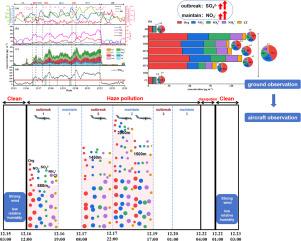华北平原一次雾霾污染期间气溶胶的飞机观测:时空分布、垂直分布和理化特征
IF 4.4
2区 地球科学
Q1 METEOROLOGY & ATMOSPHERIC SCIENCES
引用次数: 0
摘要
大气气溶胶通过与行星边界层(PBL)结构的双向反馈机制,是霾污染形成的关键驱动因素。利用2016年华北平原一次严重雾霾天气的地面和飞机观测资料,研究了大气气溶胶的时空分布、垂直分布和演化特征。结果表明,雾霾污染中的PM2.5经过3个爆发阶段(OB)和3个维持阶段(MT)逐渐积累。地面观测气溶胶数浓度(Na)呈单峰分布,揭示了霾污染在不同污染阶段的不同形成和演化特征。值得注意的是,NO3−促进了污染的积累,而SO42−促进了污染的维持。飞机观测资料显示,霾污染影响高度在不同阶段有所不同,分别为850 m (OB1)、1450 m (OB2)、2200 m (MT2早期)和1500 m (MT2后期)。在OB1和OB2期间,NO3−的比例在影响高度以上呈下降趋势,而SO42−的比例呈相反趋势。与OB相相比,MT2期间NO3−和SO42−的贡献在影响高度以下显著增加,而Org的贡献则降低。在影响高度以下,OB相的Na随高度先升高后降低,而MT相的Na随高度呈显著降低趋势。Na在不同海拔、不同相位的光谱分布相似,但随海拔的升高差异逐渐增大。在MT2后期2000 m处发现了窄谱宽,反轨迹分析表明蒙古上空长距离输送的气团可能是主要原因。本文章由计算机程序翻译,如有差异,请以英文原文为准。

Aircraft observations of aerosols during a haze pollution in the North China Plain: Spatial-temporal distribution, vertical distribution and physicochemical characteristics
Atmospheric aerosols serve as critical drivers of haze pollution formation through bidirectional feedback mechanisms with planetary boundary layer (PBL) structure. Here, ground and aircraft observations from a severe haze pollution event in the North China Plain (NCP) in 2016 were analyzed to study the spatial and temporal distribution, as well as the vertical distribution and evolutionary characteristics of aerosols. Results suggested that PM2.5 in the haze pollution gradually accumulated through three outbreak phases (OB) and three maintenance phases (MT). A unimodal distribution was observed from ground-based observations of aerosol number concentration (Na), revealing the different formation and evolution characteristics of haze pollution across different pollution phases. Notably, NO3− drove the accumulation of pollution while SO42− drove the maintenance. The aircraft observations data showed that the influence height of haze pollution varied at different phase, which were 850 m (OB1), 1450 m (OB2), 2200 m (early MT2) and 1500 m (late MT2). The proportion of NO3− decreased above influence height during OB1 and OB2, whereas that of SO42− exhibited the opposite trend. Compared with OB phases, the contributions of NO3− and SO42− significantly increased below influence height during MT2, whereas the contribution of Org decreased. Na of OB phases initially increased and then decreased with height below influence height, while during the MT phase, it exhibited a significant decreasing trend with height. The spectra distribution of Na was similar at different altitudes and phases, but the differences increased gradually with altitude. A narrow spectral width was found during late MT2 at 2000 m, the backward trajectory analysis showed that air masses from long-distance transport over Mongolia may be a main cause.
求助全文
通过发布文献求助,成功后即可免费获取论文全文。
去求助
来源期刊

Atmospheric Research
地学-气象与大气科学
CiteScore
9.40
自引率
10.90%
发文量
460
审稿时长
47 days
期刊介绍:
The journal publishes scientific papers (research papers, review articles, letters and notes) dealing with the part of the atmosphere where meteorological events occur. Attention is given to all processes extending from the earth surface to the tropopause, but special emphasis continues to be devoted to the physics of clouds, mesoscale meteorology and air pollution, i.e. atmospheric aerosols; microphysical processes; cloud dynamics and thermodynamics; numerical simulation, climatology, climate change and weather modification.
 求助内容:
求助内容: 应助结果提醒方式:
应助结果提醒方式:


